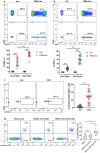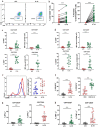Coordinated Priming of NKG2D Pathway by IL-15 Enhanced Functional Properties of Cytotoxic CD4+CD28- T Cells Expanded in Systemic Lupus Erythematosus
- PMID: 37415045
- PMCID: PMC10567942
- DOI: 10.1007/s10753-023-01860-z
Coordinated Priming of NKG2D Pathway by IL-15 Enhanced Functional Properties of Cytotoxic CD4+CD28- T Cells Expanded in Systemic Lupus Erythematosus
Abstract
Systemic lupus erythematosus (SLE) is a systemic autoimmune disorder, and numerous aberrations of T cell responses have been reported and were implicated in its pathophysiology. Recently, CD4-positive T cells with cytotoxic potential were shown to be involved in autoimmune disease progression and tissue damage. However, the effector functions of this cell type and their potential molecular mechanisms in SLE patients remain to be elucidated. In this study, we find that cytotoxic CD4+CD28- T cells are expanded in SLE patients with flow cytometry analysis, and the percentage of CD4+CD28- T cells positively correlates with the Systemic Lupus International Collaborating Clinics/ACR Damage Index (SDI). Furthermore, our study suggests that interleukin-15 (IL-15) promotes the expansion, proliferation, and cytotoxic function of CD4+CD28- T cells in SLE patients through activation of the Janus kinase3-STAT5 pathway. Further study indicates that IL-15 not only mediates the upregulation of NKG2D, but also cooperates with the NKG2D pathway to regulate the activation of the phosphatidylinositol 3-kinase (PI3K)/protein kinase B (AKT) pathway. Together, our study demonstrated that proinflammatory and cytolytic CD4+CD28- T cells expand in SLE patients. The pathogenic potential of these CD4+CD28- T cells is driven by the coupling of the IL-15/IL-15R signaling pathway and the NKG2D/DAP10 signaling pathway, which may open new avenues for therapeutic intervention to prevent SLE progression.
Keywords: cytolytic function; cytotoxic CD4+CD28− T cells; inflammation; interleukin-15-NKG2D; tissue damage.
© 2023. The Author(s).
Conflict of interest statement
The authors declared no competing interests.
Figures





References
-
- Lipsky PE. Systemic lupus erythematosus: An autoimmune disease of B cell hyperactivity. Nature Immunology. 2001;2:764–766. - PubMed
Publication types
MeSH terms
Substances
Grants and funding
LinkOut - more resources
Full Text Sources
Medical
Research Materials
Miscellaneous

